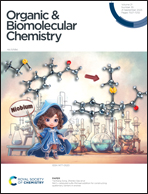Mechanistic aspects of reactive metabolite formation in clomethiazole catalyzed biotransformation by cytochrome P450 enzymes†
Abstract
Clomethiazole (CLM), a sedative and anticonvulsant drug, is commonly employed for the treatment of alcohol withdrawal syndrome because it suppresses cytochrome P450 (P450) activity associated with the generation of free radicals and liver damage. The catalyzed biotransformation of thiazole-containing drugs by P450 is known to afford reactive metabolites. These metabolites can alter the biological functions of macromolecules and result in toxicity and adverse drug interactions. Multitargeted molecular modeling and quantum chemical DFT calculations were performed to explore the binding modes and molecular mechanisms underlying the mechanism-based inactivation (MBI) of P450 by CLM. The mechanistic details associated with reactive metabolite formation from further metabolic processes were extensively assessed. Seven possible routes were proposed for CLM-P450 biotransformation including CLM hydroxylation, sulfoxidation, N-oxidation, C![[double bond, length as m-dash]](https://www.rsc.org/images/entities/char_e001.gif) N epoxidation (oxaziridine formation), and C
N epoxidation (oxaziridine formation), and C![[double bond, length as m-dash]](https://www.rsc.org/images/entities/char_e001.gif) C epoxidation. The results revealed a degree of preference for the C–N epoxidation pathway because of the low energy requirements of its rate-determining step (8.74 and 10.07 kcal mol−1 for LS and HS states, respectively). A kinetic competition for the CLM-methyl hydroxylation pathway was detected because the H-abstraction energy barrier was relatively comparable to the thermodynamically prevailing oxaziridine formation rate-determining step (12.58 and 14.52 kcal mol−1 for quartet and doublet states, respectively). Our studies assessed the mechanisms of covalent nucleophilic epoxide adduct formation through nucleophilic addition, hydrolysis of epoxidation products, and nonenzymatic degradation. CLM was shown to display P450-inhibitory activity by forming covalent adducts rather than further metabolization to reactive metabolites. The outcomes of molecular docking allowed assessing the binding profile of CLM with three human P450 isozymes, namely, CYP2E1, CYP3A4, and CYP2D6.
C epoxidation. The results revealed a degree of preference for the C–N epoxidation pathway because of the low energy requirements of its rate-determining step (8.74 and 10.07 kcal mol−1 for LS and HS states, respectively). A kinetic competition for the CLM-methyl hydroxylation pathway was detected because the H-abstraction energy barrier was relatively comparable to the thermodynamically prevailing oxaziridine formation rate-determining step (12.58 and 14.52 kcal mol−1 for quartet and doublet states, respectively). Our studies assessed the mechanisms of covalent nucleophilic epoxide adduct formation through nucleophilic addition, hydrolysis of epoxidation products, and nonenzymatic degradation. CLM was shown to display P450-inhibitory activity by forming covalent adducts rather than further metabolization to reactive metabolites. The outcomes of molecular docking allowed assessing the binding profile of CLM with three human P450 isozymes, namely, CYP2E1, CYP3A4, and CYP2D6.



 Please wait while we load your content...
Please wait while we load your content...